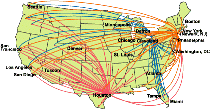United States Department of Transportation

United States Department of Transportation: Publications
Date of this Version
2009
Abstract
The hydrodynamic forces experienced by an inundated bridge deck have great importance in the design of bridges. Specifically, the drag force, lift force, and the moment acting on the bridge deck under various levels of inundation and a range of flow conditions influence the design and construction of the bridge. This report explores the forces acting on bridges in two ways. First, through physical experimentation on scaled-down bridge deck models tested in a flume and then with computational fluid dynamics (CFD) simulation models. Three bridge deck prototypes were used for the experimentation: a typical six-girder highway bridge deck, a three-girder deck, and a streamlined deck designed to better withstand the hydraulic forces. The forces (expressed as nondimensional force coefficients) on each of the bridge deck shapes were measured in the laboratory with an ultra-precise force balance under a range of inundation scenarios (including partial inundation) and at four different velocities characterized by Froude numbers in the range of 0.16 to 0.32.
CFD modeling was performed using both the Fluent® and STAR-CD® software packages. The CFD models were calibrated to the flow conditions of the six-girder bridge, and these same conditions were used for the other two bridge shapes. A range of model options were tested including two-dimensional versus three-dimensional models, different mesh resolutions, boundary conditions, and turbulence models; their effect on the accuracy of results and processing efficiency were noted.
Fitting equations were generated to create an envelope around the experimental data and create design charts for each of the bridge types and force coefficients.
Finally, the CFD models, though they can match some of the general behavior of experimental models in terms of the relationship between inundation ratio and force measured at the bridge, do not yet faithfully reproduce the critical values of the hydraulic forces and show very little response to velocity. The CFD simulations seem promising as a method to test bridge designs, but more research is needed before complex designs can be tested wholly in the CFD realm. However, the design charts from the experimental results should be a valuable tool for the bridge designer in a wide range of design applications.


Comments
Published in Report No. FHWA-HRT-09-028 (2009) 48 p.